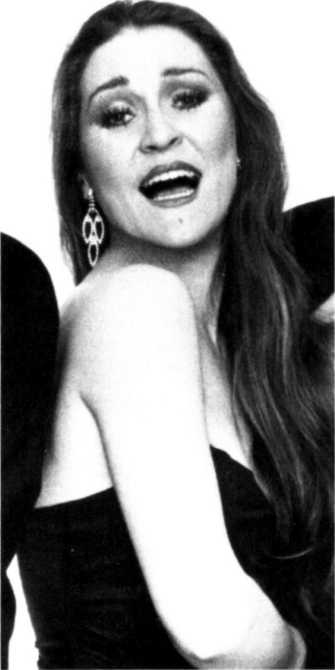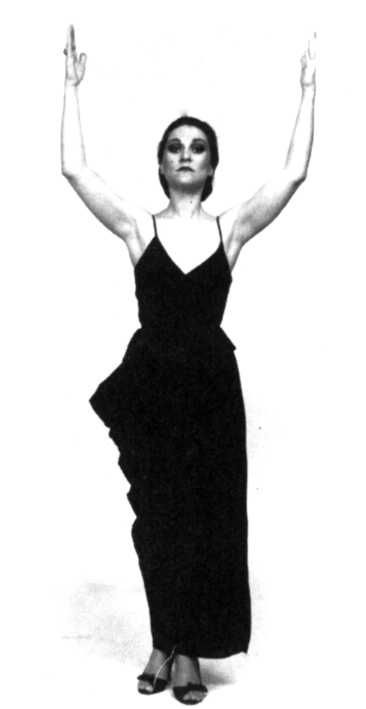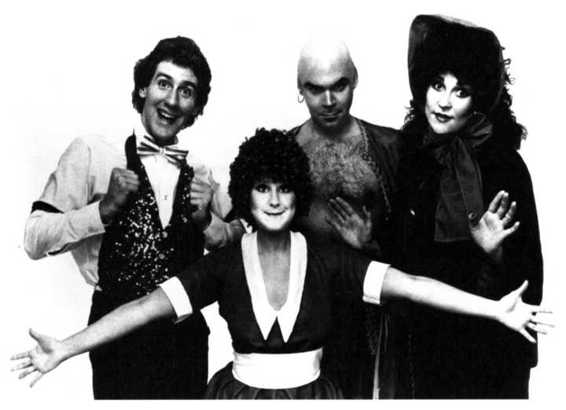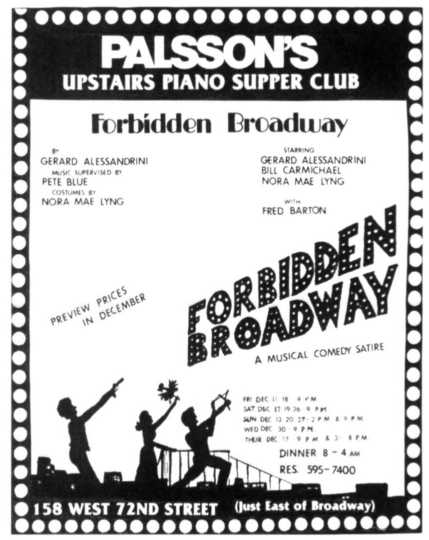Forbidden Broadway: Behind the Mylar Curtain (9 page)
Read Forbidden Broadway: Behind the Mylar Curtain Online
Authors: Gerard Alessandrini,Michael Portantiere

I met Gerry in Florida, when we were doing this dreadful, non-Equity production of
The Unsinkable Molly Brown at a Wild West theme park. The producer- slash- director
was formerly with the Ice Capades, and his wife played Molly Brown. One night, when
my husband, Gerry, and I were driving back to the hotel, our car was rear-ended by
some guy whom we later found out was a drug kingpin. Our van
rolled down a hill. My husband's neck was injured, my hip was
injured, and Gerry broke his shoulder, so he left the show.

Nora Mae Lyng.
The next time I saw him, we were both working as waiters at
Lincoln Center. I had started something called "The Wednesday
Get-the-Guts-Up-to-Sing Club" for the waiters, so we could keep
ourselves in vocal shape for auditions. We hit every piano bar in
town. Gerry came to me one day and said, "Would you mind singing
some of my parody lyrics?" When I read them, I flipped out. He and
I made the rounds of the piano bar circuit, and some of the numbers really went over. This was before we did the first run-through
of Forbidden Broadway at Peter Brash's apartment.
At Palsson's, the show was a celebrity magnet, almost from day
one. I'll never forget the night Ann Miller came backstage afterwards
in a floor-length white mink coat; she pushed right past us in the
dressing room to fix the Ann Miller wig we were using in the show.
Also, from time to time, Joan Bennett used to call me for tickets for
her and her husband. One night, she asked me for an extra ticket
for "a girlfriend I'd like you to meet." It was Myrna Loy.
I always say that Forbidden Broadway became a hit because John
Lennon was shot. I should explain. The day after he was shot in front
of the Dakota, Rex Reed gave an interview where he said something
like, "It's very difficult to live in this building when you have crazy fans hanging around, hoping to see Leonard Bernstein,
Lauren Bacall, and the other celebrities who live here."
The day after that, Bacall gave an interview and said,
"It's very difficult to live in this building when you have
assholes like Rex Reed telling the world where you live."
They hated each other, and their feud escalated over
the next few months.

Nora as Eva.
Rex heard about the really mean Bacall parody in
our show, so he came to see it, and he told all his celebrity friends about it. This was just when the Night
of 100 Stars was happening at Radio City Music Hall.
All of these stars were in town, they all wanted to be
seen, and they all came to our show. Rex wrote an
amazing valentine to Forbidden Broadway that appeared in the Daily News, and that review really put
us on the map.
I knew from the beginning that Forbidden Broadway
was very special. I turned down other jobs to do it,
because it was such an amazing showcase. Thanks to
Gerry, I found out that I had a four-octave range. I was
not a trained singer-I was an actress who sang-but
he would hand me material ranging from the Bacall
number to operetta parodies,
and it really worked my voice.
I developed disciplines I didn't
know I had.
I loved being in the audience
for the twenty-fifth-anniversary
performance. The show was just
as tight as it always was, and
the cast was wonderful. There's
something about Forbidden
Broadway that brings out the
monster in everyone who does
it. That performance was so
electric, it felt like it was about
five minutes long. It was really
frustrating for me to be in the
house instead of onstage!

Nora's favorite celebrity night at FB: Myrna Loy brought Joan Bennett,
and they both met up with Phyllis Diller!
Probably the biggest blessing the universe bestowed on me when we first did Forbidden Broadway at Palsson's was my utter naivete. I didn't have a clue that shows were
actually produced and investors put up cash. I had been watching too many Mickey
Rooney-Judy Garland MGM musicals, and I was sure that if you wanted to do a hit
show, you just did it! Never mind rights, contracts, unions, theatre politics, or the feelings of Patti LuPone. So when one of the booking managers at Palsson's asked that I
expand our cast by adding his best girlfriend and his boyfriend, my first thought was,
"How sweet! He wants our show to be a family affair."
My second thought was that I wasn't sure how to write for these new actors, because
I didn't know them. I did know the very talented Bill Carmichael from working at LOOM
(Light Opera of Manhattans, and I wanted to use him in Forbidden Broadway. So I
made a deal with the booker that we would cast his girlfriend if we could cast Bill.
As green as I might have been in some ways, I understood Forbidden Broadway's
peculiar type of satire. Even though I was far too young to have ever seen Julius Monk's
"Upstairs at the Downstairs" revues, I was fascinated with that era of New York nightlife.
I tried to give Forbidden Broadway a 1950s look by having the cast appear during the
title number in tuxedos and simple black Breakfast at Tiffany's gowns. (In case you're
wondering, the men wore the tuxes and the girls wore the gowns.)
The song-blackout-song format was not only a bow to Julius Monk but also to
coinmedia dell arte, in which segments would start and end in a tableau. (Our most
famous tableau was a smoking Annie suddenly appearing in a spotlight with her hands
raised like Eva Peron. For 30 years, that image brought gales of uproarious laughter.)
Also, some of the characters we used in our show were not-too-distant relations of
the commedia archetypes.
As for spoofing Broadway itself, that was not really anything new. In the nineteenth
and early twentieth centuries, there were parody shows that actually played on Broadway. And just a season or two prior to the debut of our show, there was the hit revue Scrambled Feet. The major difference between earlier satirical escapades and our
show is that FB is completely made up of specific spoofs of current Broadway shows,
utilizing the actual music with new lyrics inserted.

Bill Carmichael (as Jim Dale), Chloe Webb (as Annie), Gerard Alessandrini (as Yul Brynner), and Nora Mae Lyng (as Linda
Ronstadt) in Forbidden Broadway.
Also, I believe we were the first show that was entirely self-referential, with lyrics
like "This is the end of Act I! Intermission!"). I remember a conversation, years later,
in which Stephen Sondheim and I were discussing the self-referential elements of
Spamalot and Dirty Rotten Scoundrels. Mr. Sondheim called them "Meta-musicals."
When I asked him what that meant, he looked shocked and said, "Don't you know
what a meta-musical is? You invented it! I'm just surprised it took so many years for
them to start copying you."
We started with five performances a week at Palsson's, and then we kept adding
on. At one point, we were doing nine a week. That was hard. We tried a "brunch" show
for a while, and once we played to a lone couple who just happened to stop by for a
romantic breakfast. They ran out when Nora belted her high E, and we literally finished
the show to an empty house. Well, I guess we needed the dress rehearsal. But the late shows, at midnight(!) on Thursdays, Fridays, and Saturdays,
were filling up with show people.
Harold Prince was there one night, and I heard he came
because he was angry that we had spoofed the Merrily We
Roll Along logo. I had even taken an ad in Back Stage that
featured my hand-drawn parody of the logo. Looking back,
I think, "What gall!" But Prince loved the show. He was very
complimentary afterwards, and he came back a few weeks
later with Stephen Sondheim!

Gerard's hand-drawn flyer for FB at Palsson's.
We had taken a few publicity photos, but we didn't have
a press agent, so the show wasn't getting coverage. Then, in
late December, Bob Ansel-one of the owners of Palsson's-
got Rex Reed to come. Rex had been having a public feud
with Lauren Bacall over something at the Dakota, where
they both lived, so he wanted to see our Bacall number. I
remember watching his reaction during the number; he was
laughing so hard that he was crying. We thought maybe he'd
write something good about the show.
New Year's came and went, and there was no review from Rex Reed in the Daily
News-but we had a full house for every performance, and all these celebrities started
to show up. First it was Prince and Sondheim, then it was Cher, then Ann Miller, then
Mary Martin, Carol Channing, and George Burns.